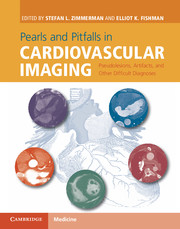 Pearls and Pitfalls in Cardiovascular Imaging
Pearls and Pitfalls in Cardiovascular Imaging Book contents
- Frontmatter
- Contents
- List of contributors
- Preface
- Section 1 Cardiac pseudotumors and other challenging diagnoses
- Section 2 Cardiac aneurysms and diverticula
- Section 3 Anatomic variants and congenital lesions
- Section 4 Coronary arteries
- Case 28 Respiratory and cardiac gating artifacts in cardiac CT
- Case 29 Overestimation of coronary artery stenosis due to calcified plaque
- Case 30 Right coronary artery pseudostenosis due to streak artifact
- Case 31 Pseudostenosis from stair-step reconstruction artifact
- Case 32 Pseudostenosis in the coronary arteries due to motion artifact
- Case 33 Pseudostenosis on curved planar reformatted images
- Case 34 Coronary stent visualization
- Case 35 Myocardial bridging
- Case 36 Intramural versus septal course for anomalous interarterial coronary arteries
- Case 37 Coronary artery fistulas and anomalous coronary artery origin
- Case 38 Giant coronary artery aneurysms
- Case 39 Caseous calcification of the mitral annulus mimicking circumflex coronary artery aneurysm
- Case 40 Vein graft aneurysms after CABG
- Case 41 Hypoattenuating myocardium
- Section 5 Pulmonary arteries
- Section 6 Cardiovascular MRI artifacts
- Section 7 Acute aorta and aortic aneurysms
- Section 8 Post-operative aorta
- Section 9 Mesenteric vascular
- Section 10 Peripheral vascular
- Section 11 Veins
- Index
- References
Case 38 - Giant coronary artery aneurysms
from Section 4 - Coronary arteries
Published online by Cambridge University Press: 05 June 2015
- Frontmatter
- Contents
- List of contributors
- Preface
- Section 1 Cardiac pseudotumors and other challenging diagnoses
- Section 2 Cardiac aneurysms and diverticula
- Section 3 Anatomic variants and congenital lesions
- Section 4 Coronary arteries
- Case 28 Respiratory and cardiac gating artifacts in cardiac CT
- Case 29 Overestimation of coronary artery stenosis due to calcified plaque
- Case 30 Right coronary artery pseudostenosis due to streak artifact
- Case 31 Pseudostenosis from stair-step reconstruction artifact
- Case 32 Pseudostenosis in the coronary arteries due to motion artifact
- Case 33 Pseudostenosis on curved planar reformatted images
- Case 34 Coronary stent visualization
- Case 35 Myocardial bridging
- Case 36 Intramural versus septal course for anomalous interarterial coronary arteries
- Case 37 Coronary artery fistulas and anomalous coronary artery origin
- Case 38 Giant coronary artery aneurysms
- Case 39 Caseous calcification of the mitral annulus mimicking circumflex coronary artery aneurysm
- Case 40 Vein graft aneurysms after CABG
- Case 41 Hypoattenuating myocardium
- Section 5 Pulmonary arteries
- Section 6 Cardiovascular MRI artifacts
- Section 7 Acute aorta and aortic aneurysms
- Section 8 Post-operative aorta
- Section 9 Mesenteric vascular
- Section 10 Peripheral vascular
- Section 11 Veins
- Index
- References
Summary
Imaging description
Coronary artery aneurysms are defined as localized vessel dilatation exceeding 50% of the adjacent normal coronary artery diameter. A precise definition of the threshold between aneurysm and “giant” aneurysm is not well established, but some authors have suggested that aneurysms > 20 mm meet this criteria. Giant coronary artery aneurysms are identified by the presence of a round or ovoid structure on the epicardial surface of the heart in the typical location for coronary arteries. Often discovered incidentally on echocardiogram, they will appear as a paracardiac mass with varying degrees of flow on Doppler interrogation depending on presence of thrombus. On non-contrast CT, they are low- attenuation, rounded masses that may have peripheral calcifications related to atherosclerosis. After contrast administration, lesions will enhance similar to blood pool, although varying degrees of thrombosis may be present (Figure 38.1). Large aneurysms can erroneously appear thrombosed on cardiac CT due to incomplete filling at the time of arterial phase acquisition (Figure 38.2). Delayed venous images will demon- strate further fill-in of the aneurysm. Cardiovascular magnetic resonance (CMR) imaging will typically show low signal on dark blood images due to flow (Figure 38.1). Steady-state free precession (SSFP) and contrast injections with gadolinium will confirm high signal in the structure due to blood and may show evidence of thrombus (Figures 38.1 and 38.2).
Importance
Patients with giant coronary aneurysms may present with life-threatening tamponade due to rupture. Thrombosis, fistulization to cardiac chambers, and embolization have also been noted in the literature. Giant coronary artery aneurysms can be misinterpreted as cardiac tumors, particularly if only limited imaging is available. The distinction between tumor and aneurysm could have significant impact on treatment.
Typical clinical scenario
Coronary artery aneurysms more commonly affect males and have an incidence between 0.3% and 5%. Coronary aneurysms greater than 20 mm are extremely rare and in one series represented only 0.02% of patients undergoing cardiac surgery. They are more likely to involve the right coronary artery.
- Type
- Chapter
- Information
- Pearls and Pitfalls in Cardiovascular ImagingPseudolesions, Artifacts, and Other Difficult Diagnoses, pp. 120 - 123Publisher: Cambridge University PressPrint publication year: 2015
